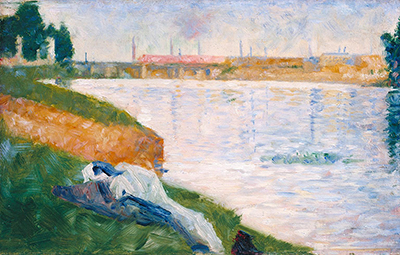"Clothes on the Grass" by Georges Seurat is a work in oil on wood, painted in France in 1883. It is a small piece, measuring 16.2cm by 24.8 cm, and is in the Tate Collection, in London, having been presented to them by Alex Reid and Lefevre in 1926.
This painting is one of a group of preparatory studies for the famous work "Bathing at Asnières", which was Seurat's first large-scale work and was painted between 1883 and 1884. The final work shows people swimming and resting by the river Seine, in a suburb to the north west of Paris.
There are fourteen of these painted studies, along with a number of drawings. Most of the painted studies were created on the spot which adds to their sense of immediacy. It is clear that the artist moved positions various times before deciding on the place from where the final viewpoint would be. They are spontaneous, depicting light and movement in the moment of painting. As such some of the figures and objects in the studies are not found in the final painting.
Stylistically this study shows a tendency to post-impressionism and was painted before Seurat had fully developed pointillism, the technique he is most well known for. The brush strokes here are wide and thick, laying on colour to create the scenery and depict the light.
"Clothes on the Grass" is primarily a view of the river, with the bridge in the background and beyond that the city, In the foreground, some white and blue clothes lie abandoned on the grass. Despite being in the foreground and being the basis of the title of the study, it is not the clothes, but the river that first attracts the viewers attention with its reflections and colour taking over a large part of the panel. The clothes are noticed after the eye is drawn to the flowing bright water and the town behind.
The clothes are shaped as if they are bodies lying on the grass and the viewer needs to look twice to check if there is anyone there. A slightly darker patch of movement in the water suggests there may be somebody swimming underwater. Because there is no sign of any people, the clothes hold some intrigue, leading the viewer to ask whose clothes they are and where the owners are. A still, calm setting is thus infused with a question and a little intrigue, a suggestive playfulness from this artist who so cleverly captures intimate moments of life within nature.




